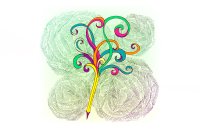Getting Creative About Critical Writing
Creative writing strategies can be useful tools in developing critical writing abilities.
Your content has been saved!
Go to My Saved Content.In middle school, students begin to write fewer poems, plays, and short stories. By the time they reach their senior year of high school, they’re writing nonfiction prose almost exclusively.
Students may, for example, write poems during a poetry unit, but literary analyses, research papers, and responses on standardized writing tests are written in nonfiction prose. The result is that other genres are sometimes devalued, and students who do their best writing and thinking in genres other than nonfiction prose are marginalized.
The devaluation of creative writing in school rests largely on the assumption that creative writing is not critical writing. But it can be: Teachers can use strategies to encourage students to write research papers as short stories, literary analyses as plays, or poetic responses to standardized writing test prompts.
Reading Creative Works as Critical Texts
When students study poems, plays, novels, and short stories as critical texts, they are primed to write critically in those genres. Students can read professionally written works in different genres and study how authors craft their arguments.
For example, the play Antigone examines whether loyalty to family or religion outweighs one’s allegiance to the state. The weight of the play gradually shifts to support Antigone’s arguments; even the antagonist, Creon, eventually admits that he is more wrong than right. Using an established work demonstrates to young writers how to create compelling arguments.
Inviting and Encouraging Creative-Critical Writing
Invitations to write creative-critical pieces can range from subtle cues like, “Last year, a student wrote her research paper as a short story,” to explicit ones like, “You can write your research paper as a short story.”
Students might be encouraged to try to break or circumvent impasses encountered when writing nonfiction prose by writing in different genres. For example, one student, frustrated with her initial attempt to write her response to a standardized writing test prompt in essay form, scrapped her first draft and successfully delivered her argument via a short dramatic play.
Students who read creative-critical pieces written by their peers are often inspired to write their own. Use peer-written mentor texts—strong examples of research papers, literary analyses, and standardized writing test responses in different genres—to inspire creative-critical writing.
Practicing Creative-Critical Writing
Students might experiment with different genres on shorter assignments like homework or classwork writing before moving on to literary papers, research papers, or standardized writing tests. One of my 11th-grade students, for example, penned a two-act screenplay for a 60-minute diagnostic before producing a dramatic play in response to our state’s end-of-course writing test.
Students are usually the most ready to experiment with creative-critical writing—it’s often adults who insist that they remain within the confines of nonfiction prose. That insistence primarily stems from a concern that creative-critical writing will not prepare students for standardized writing tests, the workplace, or college.
Students, however, can write creatively and score well on standardized writing tests. The more open the prompt and the more time allotted to student writers, the more viable creative-critical responses are.
Experimenting With Points of View
Writing from different viewpoints encourages students to see issues from multiple perspectives. One student’s research paper, a short story on the link between academic pressure and suicide in South Korea, was narrated by a Korean-American journalist. The students in the story provide statistics and anecdotes in favor of overhauling the educational system, but their principal offers a counterargument.
When students try to step into others’ shoes, they empathetically attempt new ways of seeing and thinking. More often than not, students write from their own perspectives. Matthew Cronin and Jeffrey Loewenstein, authors of The Craft of Creativity, note, “We write stories that are a lot like the stories we usually write using perspectives that are a lot like the ones we usually take.” With more creativity, however, “we change our perspective on a story.... Cognitively, it all starts when we stop advancing our stories in the usual way. We need to inquire and ultimately change our perspective.”
Incorporating Evidence
In conventional academic writing, assertions are supported with direct quotations and citations. In creative-critical pieces, students support their arguments by weaving direct quotations and citations into the narration and dialogue or referencing them via footnotes or endnotes. These are useful tools for students who find that direct quotations cannot be seamlessly integrated into their creative writing or that parenthetical citations disrupt the flow of their narratives.
Rewarding Risk, Growth, and Change
If we must grade student writing, we can implement grading systems—including portfolio-driven student self-evaluations—that explicitly reward risk, growth, and change. Sarah, one of the strongest nonfiction prose writers in my class, wrote an analysis of The Great Gatsby from the viewpoint of Holden Caulfield from The Catcher in the Rye. Eerily channeling Holden’s voice and Salinger’s style, Sarah’s piece made insights into both novels. Sarah could have stuck with tried-and-true nonfiction prose, but she had nothing to lose—and everything to gain—by experimenting with genre and point of view.
Teachers also have much to gain by allowing for creative-critical experimentation: Just as it’s often more fun to write than nonfiction prose, it’s often more fun to read. Different students do their best writing and thinking in different genres, and teachers who cultivate a variety of writing genres in their classrooms are likely to see their students’ best work.
Having students write in a variety of genres is a component of good writing instruction, and allowing students a choice of genre leads to the emergence of voice, higher levels of engagement, and greater overall gains in their writing. If we’re serious about developing critical writers—and the quality and quantity of their writing and thinking—we’re going to have to get creative.
